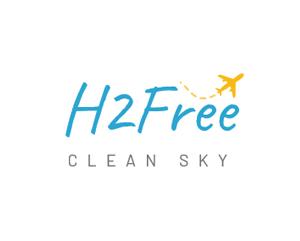H2FREE
THE PROJECT
H2Free is a Clean Sky 2 Joint Undertaking project focusing on the Investigation and modelling of hydrogen effusion in electrochemically plated ultra-high-strength-steels (UHSS) used for landing gear structures.
One drawback associated to UHSS coated components is the risk of hydrogen embrittlement (HE) and delayed hydrogen fracture of the part. The standard degassing process is applied equally to the components regardless UHSS or coating composition/morphology. However, it is known that the nature and structure of both the base material and the coating have a great influence in the hydrogen intake and degassing efficiency.

THE OBJECTIVE
The main objective of the H2Free project is to develop a practical guideline for hydrogen degassing of UHS-steels plated with LHE-Zn-Ni, with the aim of saving production costs and allowing Zn-Ni to overtake Cd coatings. The guideline will contain simple rules/formulas to provide criteria to design the degassing process, based on experimental data and on modelling to predict the hydrogen effusion in coated UHSS, the remaining hydrogen concentration in the components and so the probability of hydrogen embrittlement. With its digital approach, H2Free will accelerate materials modelling uptake into European industrial decision making and link all partners to central European materials modelling platforms and activities.

TECHNICAL CHALLENGES:
– Structural coating characterization
– Ranking of UHSS HE susceptibility
– Simulation tool
– Guidelines for HE mitigation
– Understanding of HE phenomena
– Tool to predict HE probability in complex coated parts
– Minimizing industrial rework and scrap
– Cd replacement
The following improvements will be aimed from the H2Free project:
• 4 different UHSS will be studied during the project to be classified according their facility to degas.
• 3 coating layer microstructures / morphologies will be studied.
• Permeation parameters of all heterogeneities and Hydrogen thresholds (retained H vs. HE) will be determined for all the materials.
• A model able to predict retained H and degassing time of a part will be developed,
• Determination of all undesirables morphologies/structures/zones and the possibility to local rework undesirable structures detected instead of full reprocessing.
• Reduction of average degassing time.
• Energy consumption (in the heating process) reduction for different plated UHSS compared to current procedure (AMS2759/9 standard) .
CONSORTIUM
CIDETEC Surface Engineering is the coordinator of the project and leader of two WPs.CIDETEC will electrodeposit both LHE-Zn and LHE-Cd on different UHSSs, both in laboratory and pilot plant scales, under different conditions in order to produce and characterize a broad spectrum of morphologies with different hydrogen content and will support the other partners of the project with coated specimens to be characterized regarding hydrogen permeability and hydrogen embrittlement. |
 |
HEREONhas a vast expertise on the development of new surface technologies for structural and bio materials, and the development of “predictive” modelling and simulation of service‐life aspects.HEREON is responsible of the hydrogen effusion model implementation (WP3 leader) and material dependencies to cover 4 UHSS and 2 coatings. It will be also responsible to run system sensitivity analysis. |
 |
| ELSYCA is a worldwide reference solutions provider to improve functional electroplating process performance by means of Computer Aided Engineering (CAE) solutions. Its knowledge and expertise in electrochemistry and related CAE projects have been used, among other applications, in numerous analyses and optimization studies of Zn-Ni and Cd plating processes on landing gears parts.In the framework of the H2Free Project, Elsyca brings its expertise in CAE modeling to develop robust and accurate modeling of the H-adsorption /effluence effects ultimately up-scaling the applicability of this model to industrial applications. |  |
AZTERLANadds to the consortium an extensive expertise in the study of HE and re-embrittlement, which covers a broad variety of UHSS compositions and production processes.AZTERLAN participates actively in the project specifications definition and is responsible of UHSS tests specimens manufacturing and conducts the determination of the degassing kinetics and HE tests (proposing a fast method for HE characterization: SPT). |
 |
| ELHCO is responsible of the validation of the recommendations and rules generated among the project at an industrial environment.ELHCO has the experience and the technical knowledge to perform surface treatments for aerospace industry. They own NADCAP accreditation for Chemical Processing (CP) and AIRBUS qualification (they are one of the 13 qualified Zn-Ni suppliers all over the world). |  |
MAX-PLANCK INSTITUT FÜR EISENFORSCHUNG (MPIE) is a leading materials research institute with main focus on metallic alloys. Hydrogen in materials and HE are key research topics at MPIE. Special attention deserves its capabilities to perform hydrogen measurements with very high precision.MPIE is the main responsible of hydrogen permeation tests and TDAto determine hydrogen trap distribution and specific diffusion coefficients and solubility, and kind of the different trap sites in the steels to provide accurate data for the H2 diffusion model. |
 |
TOPIC MANAGER

Hasiera: 01 | 01 | 2021
Amaiera: 30 | 04 | 2023
Budget: 999.897,50 €
Financiator


This project has received funding from the Clean Sky 2 Joint Undertaking (JU) under grant agreement No 101007712. The JU receives support from the European Union’s Horizon 2020 research and innovation programme and the Clean Sky 2 JU members other than the Union.
Sectors
- Aeronautika
Technological fields
- Hidrogenoaren produkzioa, garraioa, biltegia eta erabilpena
- REACH erregelamenduarekin bat datozen gainazalak
Kontaktuak
Dr. Jorge Rodríguez
Phone:
Dr. Maria Lekka
Phone:










